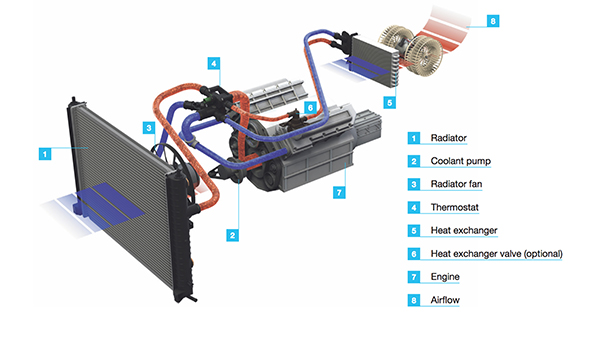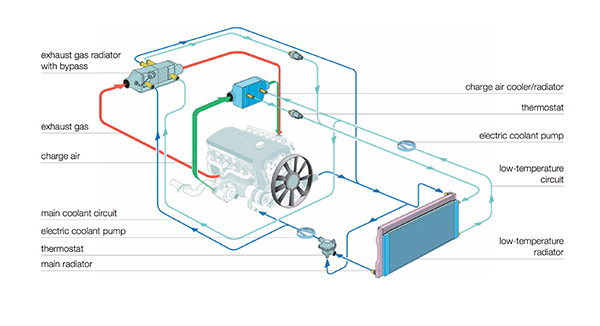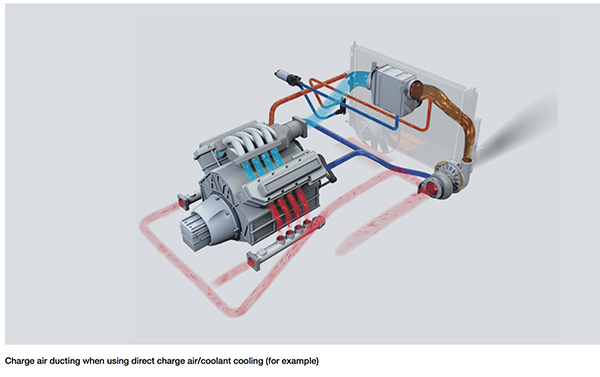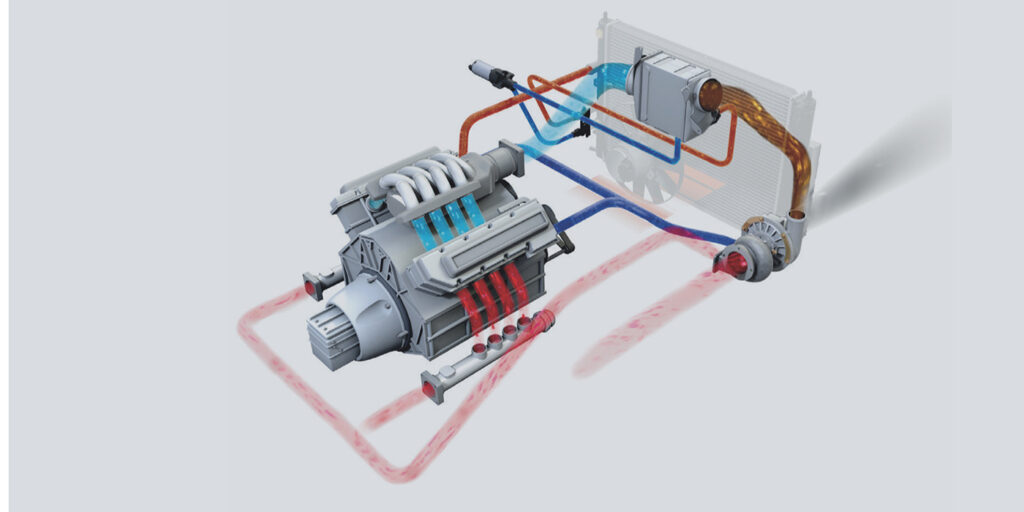As automotive manufacturers look for more advanced methods to achieve high fuel economy along with low emissions, the role of thermal management in engines has come to the forefront.
In the past, “thermal management” only meant getting the engine’s internal components to their optimum temperature as quickly as possible and preventing overheating. Today, thermal management has taken on a much more critical role of maintaining temperatures within a narrow range and has expanded to include the intake air and other related areas like direct and indirect charge air, fuel and exhaust gas recirculation (EGR).
Our MAHLE Behr division is one of the leading producers of coolant pumps, thermostats, and technologically sophisticated thermal management products, so we play a role in helping engine builders understand how the interplay of these thermal management systems impacts the mechanical systems within the engine. In this article, we will review the cooling system and discuss how controls have evolved with the introduction of microprocessors and computers, and then look at ancillary thermal management devices that are being used to affect engine performance.

Cooling System Evolution
Without cooling, the temperatures generated during fuel combustion (over 3,500 degrees Fahrenheit) can be detrimental to the operation of an internal combustion engine (ICE). The first automotive engines were cooled using the principle of thermosiphon, where the heated, lighter water rises through a manifold into the upper part of the radiator. As the water flows, it is cooled by the airstream and, since it gets heavier, sinks to the bottom of the radiator and then flows back to the engine. This circuit remains in operation as long as the engine is running.
As engine technology advanced, a water pump was added to improve coolant flow. By the 1920s, a thermostat was introduced to “warm up the engine quickly and prevent it from cooling down,” as described in period literature.
The thermostat brought about a crucial improvement in engine thermal management. As long as the desired engine operating temperature is not reached, the water is short-circuited to pass back into the engine. Only when the desired operating temperature is reached does the thermostat open and allow coolant to flow into the radiator. This not only improved the performance of the engine by allowing it to get to a proper operating temperature quicker, but it also made passengers more comfortable in cold weather by making a heater practical.
As time went on, other improvements were introduced, like the pressurized cooling system to raise the boiling point, and the adoption of ethylene glycol antifreeze to prevent coolant freezing, increase the boiling point and protect engine and cooling system components from corrosion.
Turbocharging Equals More Cooling
The trends toward increasing engine performance and downsizing are leading to an increasing proportion of turbocharged engines in passenger cars. The performance of an ICE depends on the amount of fuel burned. In an ICE, 1 kilogram (kg) of fuel requires 14.7 kg of air for complete combustion (a diesel engine requires 14.67 kg air for 1 kg fuel). This is why the widespread use of turbocharging on engines is an effective means of increasing engine performance.
Most engines today utilize a charge air cooler, which increases air density, increasing the output and efficiency of the engine. There is an additional benefit to charge air cooling – the ability to control the temperature of the engine process air by regulating the charge air cooling. This thermal control is made necessary by the steadily increasing demands on exhaust gas after-treatment.
Exhaust gas recirculation (EGR) coolers take some of the primary exhaust gas flow between the exhaust manifold and the turbocharger, cool it in a special heat exchanger (EGR cooler), and then feed it back into the intake air. This decreases the combustion temperature in the engine, reducing the formation of nitrogen oxides.

New Thermal Management
As automotive manufacturers look for every way to improve engine performance and reduce emissions, they are taking a closer look at how the cooling system can manage temperature while using less engine power. Traditional mechanical coolant pumps, which are driven directly by the engine, continuously deliver coolant while the engine is running, even when there is no need for cooling. In contrast, electric coolant pumps and their integrated electronic control are variably activated according to the required cooling performance.
During a cold start, an electric coolant pump initially pumps no coolant. This allows the engine to reach its operating temperature faster. Even when idling or after turning off the engine, an electric coolant pump can deliver sufficient cooling capacity since it is not crankshaft-driven. This demand-driven cooling of the engine lowers the power requirement, reducing friction losses, fuel consumption, and emissions.
However, if we can control the coolant temperatures based on demand, why not look at all the areas in an ICE’s operation where temperature plays a role? When the engine is cold and when there are low ambient temperatures, the engine and catalytic converter can reach optimal operating temperature quicker by eliminating charge air cooling on turbocharged engines. This results in lower cold-start emissions, mainly hydrocarbons (HC).
With a charge air cooler using forced air, this is only possible using a bypass on the charge air side, which can be complicated. With charge air cooling using a coolant, simple control of the coolant volume flow rate not only allows the cooling of the charge air to be suspended, but also makes it possible to regulate its temperature.
By linking the coolant circuit for charge air cooling with engine cooling, and with intelligent control of the coolant flow rates, indirect charge air cooling can be expanded to include charge air temperature control. Either the hot coolant of the engine circuit or the comparatively cooler coolant of the low-temperature circuit can flow through the charge air cooler to regulate the temperature.
In passenger cars, the rising demand for cooling performance conflicts with the increasingly restricted installation space in the vehicle’s engine area. The conflict between installation space and power requirements can be resolved with two new approaches – charge air precooling and indirect charge air cooling.
Intake Air Temperature Management (ATM)
ATM consists of three subsystems: indirect charge air cooling, cooled exhaust gas recirculation, and intake air heating. These subsystems are linked and controlled in such a way that the intake air can be cooled and heated and the combustion temperature raised and lowered. The temperature is lowered by cooling the charge air and exhaust gases and by introducing as much exhaust gas to the charge air as possible. To increase the combustion temperature, the charge air and exhaust gas cooling are suspended, and the charge air can also be heated.

Indirect charge air cooling
One way of resolving the dilemma between installation space and power requirements is the use of indirect charge air cooling. In the passenger car, this generally consists of a complete coolant circuit for the charge air cooler that is independent of the engine cooling circuit.
Compared with charge air precooling (direct), indirect charge air cooling results in significantly reduced charge air pressure loss, improved engine dynamics thanks to the lower volume of charge air, higher dynamic cooling capacity, and improved engine efficiency due to an increase in charge air density.
Cooled exhaust gas
ATM also applies to areas like exhaust gas recirculation (EGR), used to reduce the oxygen concentration in the cylinder, lowering the temperature and speed of combustion. In high-pressure EGR, the exhaust gas is extracted upstream of the turbocharger, cooled in the exhaust gas cooler, and then mixed into the charge air. If the intake air temperature needs to be raised, the exhaust gas cooler is bypassed.
Intake air heating
With ATM, the intake air can be heated in four ways – by discontinuing charge air cooling, the exhaust gas cooling, by discontinuing both, or by heating the charge air. For heating, a partial flow of hot coolant is branched off from the engine cooling circuit and guided to the charge air cooler.
As an engine builder in today’s microprocessor-controlled world, it is not enough to know the mechanical nuances of automotive power plants. The quest for ever-stringent fuel economy and emissions standards means that every aspect of engine operation is controlled within tight parameters. The use of active thermal management systems to control the temperature of charge intake air is becoming more commonplace and more sophisticated. To ensure the proper operation of a modern rebuilt engine, working knowledge of these ATM systems is essential. EB
Dan Harris is a business development manager for MAHLE Aftermarket Inc., responsible for thermal management products. In this role he is responsible for all aspects of marketing the MAHLE Behr product lines.














